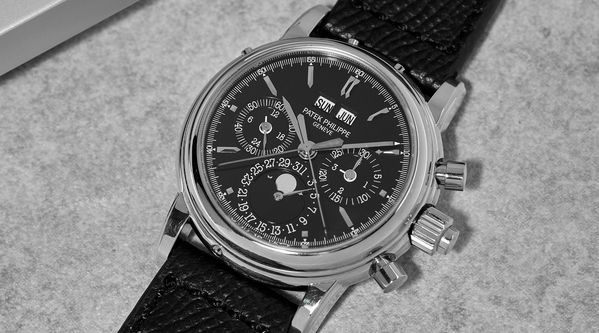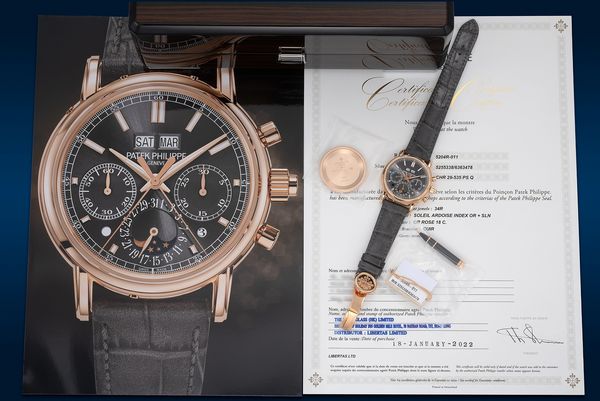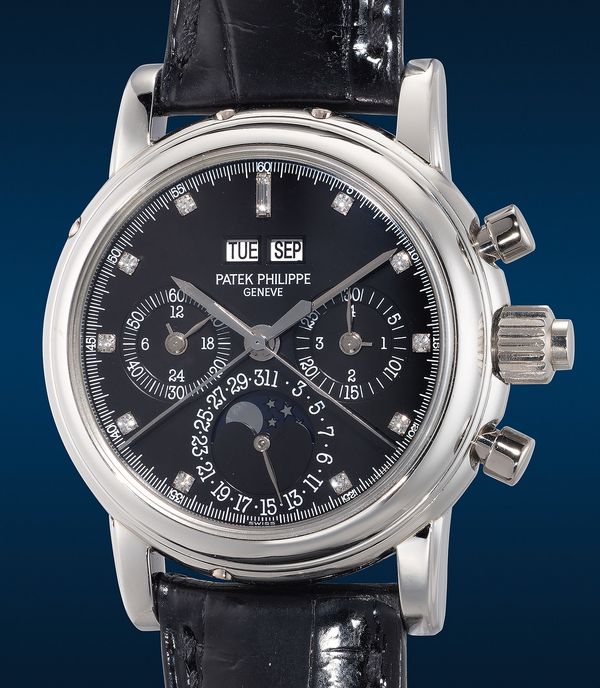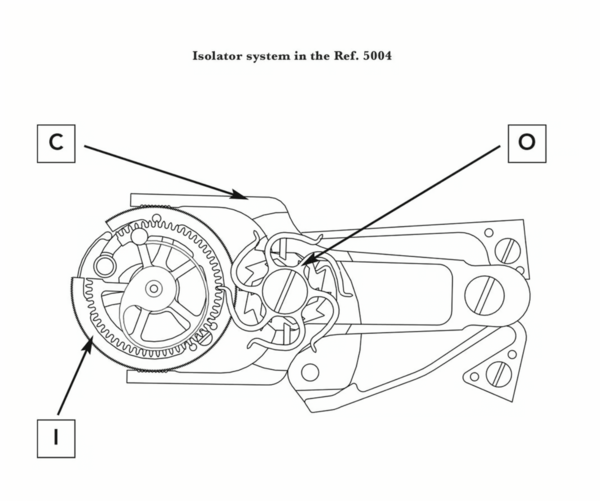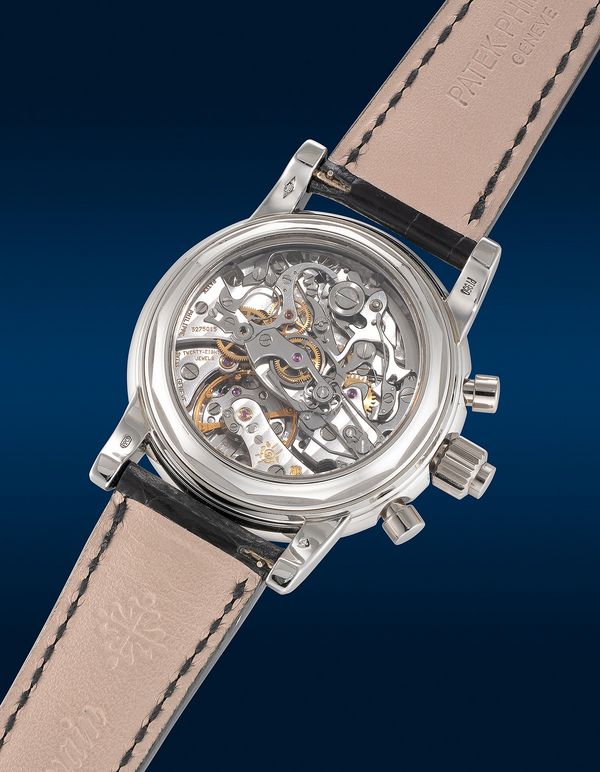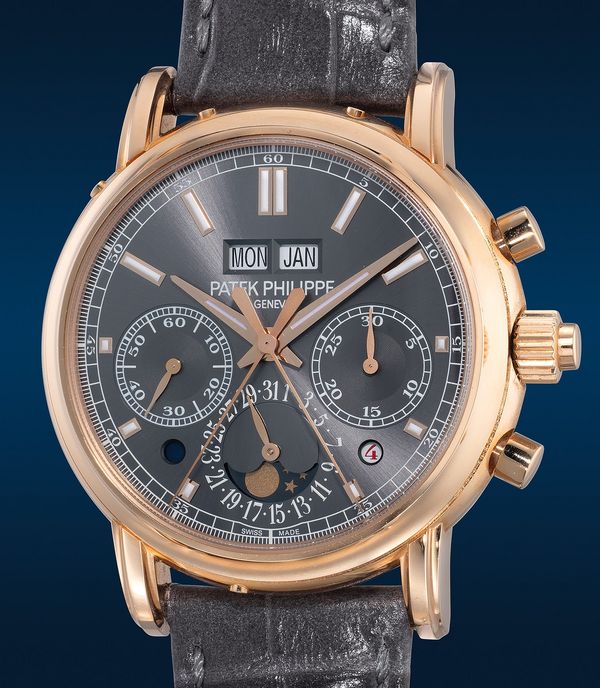The PHILLIPS Hong Kong Watch Auction: XVIII, takes place on May 24 and 25, 2024, at our West Kowloon headquarters. The auction includes more than 280 of the world's finest watches – and naturally, there are a number of extraordinary pieces from Patek Philippe, including representatives from the brand's two successive generations of perpetual calendar split-seconds chronographs, the ref. 5004 and the ref. 5204.
To celebrate the upcoming auction, we're republishing one of our top stories from earlier this year, which compares the two generations to determine which one might be best for your collection.
– By Logan Baker
The perpetual calendar chronograph wristwatch is one of Patek Philippe's cornerstones as a watchmaker. The line has been in continuous production ever since 1940, when the original ref. 1518 was introduced, eventually resulting in five core references (ref. 1518, ref. 2499, ref. 3970, ref. 5970, ref. 5270).
It is, however, only in the past 30 years, that Patek Philippe has paired a split-seconds chronograph with a perpetual calendar.
The watch that broke this new ground was the ref. 5004, a now-legendary wristwatch that remained in production for an impressive 17 years before it was finally replaced in 2012, by the next-gen ref. 5204, which was fully kitted out with the brand-new in-house caliber CHR 29-535 PS Q.
The 5004 is still today regarded as one of Patek Philippe’s true modern classics, perhaps only equaled in its post-1990s-era acclaim by the ref. 5970. It's a watch that was truly born out of Philippe Stern’s tireless leadership and his desire to position Patek Philippe once again as Switzerland's true leader in complicated watchmaking. If wearability (it's only 36mm!) and complicated watchmaking are the most important things to you in collecting, then it's hard to go wrong with potentially adding a ref. 5004 to your collection. It's a watch that will remain desirable for decades.
And yet, the same holds true for the ref. 5204. Despite its current status as a production model today, it remains a deeply impressive and hard-to-acquire watch, not to mention the fact that it incorporates numerous improvements on many of the 5004's original technical achievements.
If you've got the cash to splash, and you're on the hunt for the absolute best complicated Patek Philippe for your collection, then you'll naturally struggle with the question of which of Patek Philippe's perpetual calendar split-seconds chronographs are right for you.
Don't worry – hopefully our new guide on the topic helps lead you to the right choice.
The Classics Are Classic For A Reason: What To Know About The Ref. 5004
Quick Facts:
Production Years: 1994-2012
Case Metals: 18k rose gold (5004R), 18k yellow gold (5004J), 18k white gold (5004G), platinum (5004P), titanium (5004T, unique piece for Only Watch 2013), and stainless steel (5004A, 50 end-of-series pieces produced in 2011/12)
Case Size: 36.7mm × 15mm
Complications: Hours, minutes, seconds, date, month, day of week, perpetual calendar, split seconds chronograph, moonphase, 24-hour display, leap year indication
Movement: Caliber CHR 27-70 Q, manual wind with column wheel, based on Lemania 2310, 24 jewels
Power Reserve: 60 hours
Frequency: 18,000 vph, or 2.5Hz
Certification/Hallmark: Geneva Seal
It's long been reported that Patek Philippe was able to produce no more than 12 examples of the ref. 5004 per year – in any case metal – during its production lifecycle, simply as a result of the sheer complexity of the movement construction. As a result, the ref. 5004 is typically regarded as one of the rarest series-produced complicated watches by Patek Philippe in the modern era.
If that annual production total is accurate, that means Patek Philippe likely produced somewhere in the neighborhood of 250 examples of the ref. 5004 in total, including the end-of-series run and the titanium unique piece for the Only Watch 2013 charity auction.
Extremely well-received at launch, the ref. 5004 was the last watch of its kind at Patek to be driven by a Lemania-based movement, the caliber CH 27-70 Q.
The development of this movement wasn't without issues. There's a reason it took so long for Patek Philippe to attempt combining a perpetual calendar with a split-seconds chronograph, after all – and it didn't help that the Lemania 2310 was never designed to support split-seconds capability to begin with.
Patek Philippe addressed its primary architecture issue by extending the single pinion that holds all the central hands in place to the furthest degree possible. Patek's watchmakers then had to develop a way to deal with the excess friction that would naturally build up when the split-seconds wheel is stopped.
The solution involved introducing a multi-prong isolating mechanism on top of the split-seconds lever that would physically lift up the rattrapante lever once the split-seconds mechanism was activated, so that no unnecessary torque would be placed on the heart-shaped cam. Collectors have taken to calling this the "Octopus" lever due to its numerous long, winding arms.
One of the issues that arises when using an isolating system in a rattrapante chronograph, however, is a natural increase in case and movement thickness. The ref. 5004 is admittedly a stout watch, with a 36.7mm × 15mm profile; its figure has even earned it the nickname of "cheeseburger" from some collectors due to its thickness and multi-level case construction.
Meanwhile, on the dial side, Patek Philippe raided its archive when designing the 5004's face. The Arabic hour markers found on all the precious metal 5004s are clearly similar to those found on the ref. 1518 and the first two generations of the ref. 2499. There's no tachymeter scale, instead only a simple printed railroad track for the passing minutes and seconds. Leaf-shaped hands are consistent throughout all known 5004 examples.
Patek Philippe expectedly produced a number of custom or one-off pieces for its top clients, most famously a pair of 5004s for Rock and Roll Hall of Famer Eric Clapton, consisting of a platinum 5004P with a blue dial and tachymeter (which sold at Phillips Hong Kong, in May 2016) and a 5004R with a black dial and tachymeter scale (which sold at Phillips Hong Kong, in November 2016). We also once sold a well-known former entertainment executive's special-order 5004J with a black dial, tachymeter scale, and recognizable "MSO" six o'clock signature at Phillips Hong Kong, in November 2018.
Although the ref. 5004 was officially retired in 2011, an exclusive commemorative "end-of-run" series of 50 5004s in stainless steel was released by Patek Philippe that year. These watches were only available for purchase by Patek's top clients through the company's official Salon in Geneva; Patek even noted the occasion by offering clients a caseback engraving of their name.
Interest in the ref. 5004 has continued to increase since it was discontinued over a decade ago. Outside of any unique or special-order pieces, the most desirable examples are typically considered to be the 5004G and 5004A. Phillips has sold a total of 31 ref. 5004 examples; you can explore our full list of results right here.
The Future Is Now: What To Know About The Ref. 5204
Production Years: 2012-present
Case Metals: 18k rose gold (5204R), 18k white gold (5204G), and platinum (5204P)
Case Size: 40mm × 14.3mm
Complications: Hours, minutes, seconds, date, month, day of week, perpetual calendar, split seconds chronograph, moonphase, 24-hour display, leap year indication
Movement: In-house caliber CHR 29‑535 PS Q, manual wind with column wheel, 34 jewels
Power Reserve: 65 hours
Frequency: 28,800 vph, or 4Hz
Certification/Hallmark: Patek Philippe Seal
The ref. 5204 was introduced at Baselworld 2012 as the replacement for the now-retired ref. 5004. It was the first perpetual calendar chronograph wristwatch, split-seconds or not, to feature Patek Philippe's new in-house caliber CHR 29-535 PS Q, finally separating Patek from the historic Lemania base movement.
Unlike the movement in the 5004, the CHR 29-535 PS Q caliber was indeed designed from the ground up with additional capabilities in mind, including the option for a split-seconds chronograph. That means no more of that endearing "octopus" lever.
Patek Philippe ended up going without fixing a typical isolator wheel spring to the top of the split-seconds wheel, instead integrating the spring directly into the split-seconds column wheel cap. This new type of isolating mechanism is then able to rotate between its two positions without needing to overpower the brake spring each time.
It's a design that Patek says is much better for the movement's long-term reliability than the split-seconds system found in the original 5004.
The heart cam used in the 5204's split-seconds mechanism was also redesigned for a cleaner fit alongside the return lever, resulting in a more precise resetting process for the two chronograph seconds hands, when they snap back to the 12 o'clock position. Patek Philippe mentions an improvement in the realm of 75 percent for this feature compared to the 5004.
And thanks to the new isolating system, Patek Philippe was able to shrink the 5204's thickness compared to the 5004. The movement is now just 8.7mm tall, a decrease of 0.7mm in case height.
Phillips has sold a total of 8 ref. 5204 examples; you can explore our full list of results right here.
To The Victor Goes The Spoils
The Patek Philippe 5204 does have a more reliable engine than the ref. 5004, but that results in a significantly larger diameter at 40mm compared to the 5004's 36mm width, despite the thinner profile. The 5204 is also still in production, which means there's always a chance for future attractive releases to come out in the line, while the 5004 is, of course, totally discontinued.
The ref. 5004 is one of Patek Philippe's best-known modern watches for a reason. It's influential across the entire watch industry and a genuine historical reference in Patek's long history. The ref. 5204, meanwhile, certainly improves on the 5004's goals, but it's always tricky to judge merits between the charm of an original hit release with a sequel that's been polished up and technically improved.
However, at the end of the day, you can't go wrong with either choice.
You can learn more, place a bid, and view the entire Hong Kong Watch Auction: XVII catalog here, and the New York Watch Auction: NINE, here.
About Phillips In Association With Bacs & Russo
The team of specialists at PHILLIPS Watches is dedicated to an uncompromised approach to quality, transparency, and client service. Phillips in Association with Bacs & Russo holds the world record for the most successful watch auction, with its Geneva Watch Auction: XIV having realized $74.5 million in 2021. Over the course of 2021 and 2022, the company sold 100% of the watches offered, a first in the industry, resulting in the highest annual total in history across all the auction houses at $227 million.
About Logan Baker
Logan has spent the past decade reporting on every aspect of the watch business. He joined Phillips in Association with Bacs & Russo at the start of 2023 as the department's Senior Editorial Manager. He splits his time between New York and Geneva.
Recommended Reading
An In-Depth Collectors’ Guide To The Patek Philippe Chronograph Ref. 5070
The Imperial Patek Philippe: A Short Documentary
Compact Dimensions And Complicated Watches: A Look At Patek Philippe Under Philippe Stern
